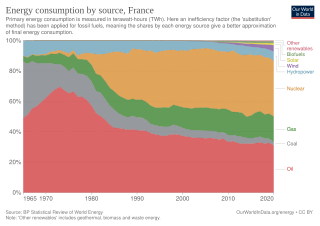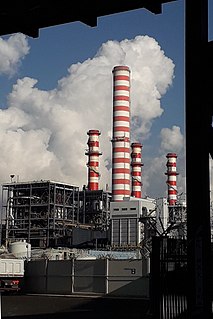Related Research Articles
Smeg or SMEG may refer to:

According to the International Energy Agency, France has historically generated a very low level of carbon dioxide emissions compared to other G7 economies due to its reliance on nuclear energy. Energy in France is generated from five primary sources: coal, natural gas, liquid fuels, nuclear power, and renewables. In 2020, nuclear power made up the largest portion of electricity generation, at around 78%. Renewables accounted for 19.1% of energy consumption. France has the largest share of nuclear electricity in the world. The country is also among the world's biggest net exporters of electricity. The country is increasingly investing in renewable energy and has set a target of 32% by 2030.

Renewable energy in Finland grew to 38.7% of total final energy consumption by year end 2014, achieving joint second position with Latvia in terms of renewable energy consumption by share amongst the EU-28 countries, behind its neighbour Sweden in first position on a 52.6% share. The 2014 share in Finland breaks down as renewable energy providing 52% of the heating and cooling sector, 31.4% of the electricity sector and 21.6% of the transport sector. By 2014, Finland had already exceeded its 2020 target for renewable energy use under the EU renewable energy directive as shown in the table of country targets.
Nordic electricity market is a common market for electricity in the Nordic countries. It is one of the first free electric-energy markets in Europe and is traded in NASDAQ OMX Commodities Europe and Nord Pool Spot. In 2003, the largest market shares were as follows: Vattenfall 17%, Fortum 14.1%, Statkraft 8.9%, E.on 7.5%, Elsam 5%, Pohjolan Voima 5%. Other producers had 42.5% market share.

Energy in Finland describes energy and electricity production, consumption and import in Finland. Energy policy of Finland describes the politics of Finland related to energy. Electricity sector in Finland is the main article of electricity in Finland.

Energy in Belgium describes energy and electricity production, consumption and import in Belgium.

The energy sector in Switzerland is, by its structure and importance, typical of a developed country. Apart from hydroelectric power and firewood, the country has few indigenous energy resources: oil products, natural gas and nuclear fuel are imported, so that by 2013 only 22.6% of primary energy consumption will have been covered by local resources.

Energy in Italy come mostly from fossil fuels. Among the most used resources are petroleum, natural gas, coal and renewables. Italy has few energy resources, and most of supplies are imported.

The electricity sector in Finland relies on nuclear power, forest industry black liquor and wood consumption, cogeneration and electricity import from neighboring countries. In 2008 the consumption of electricity in Finland was 17 036 kWh/person. The European union (15) average was 7 409 kWh/person. Co-generation of heat and electricity for industry process heat and district heating is common in Finland. Finland is one of the last countries in the world still burning peat.

Energy in Singapore describes energy related issues in Singapore, which is a developed country located in eastern Asia. Energy exports to others are about three times the primary energy supplied in the country itself. Additionally, oil imports in relation to the population demands of the country itself are concerningly high.

Energy in Sweden describes energy and electricity production, consumption and import in Sweden. Electricity sector in Sweden is the main article of electricity in Sweden. The Swedish climate bill of February 2017 aims to make Sweden carbon neutral by 2045. The Swedish target is to decline emission of climate gases 63% from 1990 to 2030 and international transportation excluding foreign flights 70%. By 2014 just over half of the country's total final energy consumption in electricity, heating and cooling and transport combined was provided by renewables, the highest share amongst the 28 EU member countries. About a third of Sweden's electricity is generated by nuclear power. In generating a year's worth of this energy, Swedes generate about 4 tonnes of CO2 emissions each. Since 2010, sustainability measures have reduced total emissions even as the population has increased.

Energy in Portugal describes energy and electricity production, consumption and import in Portugal. Energy policy of Portugal will describe the politics of Portugal related to energy more in detail. Electricity sector in Portugal is the main article of electricity in Portugal.

Energy policy of Finland describes the politics of Finland related to energy. Energy in Finland describes energy and electricity production, consumption and import in Finland. Electricity sector in Finland is the main article of electricity in Finland.

Climate change in Finland has far reaching impacts on the natural environment and people of Finland. Finland was among the top five greenhouse gas emitters in 2001, on a per capita basis. Emissions increased to 58.8 million tonnes in 2016. Finland needs to triple its current cuts to emissions in order to be carbon neutral by 2035. Finland relies on coal and peat for its energy, but plans to phase out coal by 2029. Finland has a target of carbon neutrality by the year 2035 without carbon credits. The policies include nature conservation, more investments in trains, changes in taxation and more sustainable wood burning. After 2035 Finland will be carbon negative, meaning soaking more carbon than emitting.

Energy in Lebanon is dominated by oil, which represents more than 95% of the primary energy consumed in 2017. The great majority of energy used in the country is imported. The energy market in Lebanon is characterized by sharply rising consumption, and frequent shortages due to dilapidated infrastructure partly destroyed by the civil war that ravaged the country between 1975 and 1990.
Energy in Luxembourg describes energy and electricity production, consumption and import in Luxembourg. Energy policy of Luxembourg will describe the politics of Luxembourg related to energy in greater detail. Electricity sector in Luxembourg is the main article of electricity in Luxembourg.

Primary energy use in Slovakia was 194 TWh and 36 TWh per million inhabitants in 2009.
Despite the historic usage of wind power to drain water and grind grain, the Netherlands today lags behind all other member states of the European Union in the production of energy from renewable sources. In 2019, the Netherlands produced just 8.6% of its total energy from renewables.[data unknown/missing] According to statistics published by Eurostat, it is the last among the EU countries in the shift away from global warming-inducing energy sources. The leading renewable sources in the country are biomass, wind, solar and both geothermal and aerothermal power. In 2018 decisions were taken to replace natural gas as the main energy source in the Netherlands with increased electrification being a major part of this process.
The Monaco Electricity and Gas Company is a Monegasque concessionaire which distributes and supplies electricity and gas for the entire Principality of Monaco, which is over 25 000 customers and commercial entities. It operates public lighting and maintains the 7,200 light points in the area.

World energy supply and consumption is global production and preparation of fuel, generation of electricity, energy transport, and energy consumption. It is a basic part of economic activity. It includes heat, but not energy from food.
References
- ↑ "Shareholding". SMEG. Retrieved 2020-06-09.
- ↑ "seaWergie, District heating and Cooling networks in Monaco". SMEG. Retrieved 2020-06-10.
- ↑ "Distribution de l'Electricité" [Electricity Supply]. SMEG (in French). Retrieved 2020-06-09.
- ↑ "Our history - The post-war period". SMEG. Retrieved 2020-06-09.
- ↑ Australia ratifioi Kioton sopimuksen 3.12.2007 YLE (in Finnish)
- ↑ Suomen kasvihuonekaasupäästöt 1990–2008, 3. korjattu painos Statistics Finland Katsauksia 2010/1, Ympäristö ja luonnonvarat http://www.tilastokeskus.fi/kasvihuonekaasut page 47(in Finnish)
- ↑ Tutkijoiden hätähuuto: Ilmastonmuutos happamoittaa meret Archived 2009-04-15 at the Wayback Machine YLE 31.01.2009 (in Finnish)
